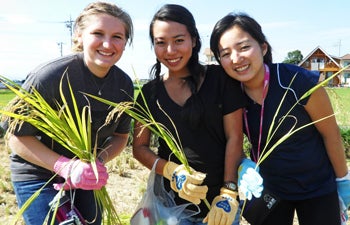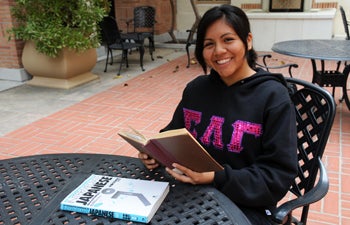Land of the Rising Sun in the City of Angels
Wendy Barrios was on the fourth floor of a building at Tokyo International University (TIU) the afternoon of March 11, 2011, when the floor began to tremble. She was taking a break between her classes at TIU, where she was participating in a study abroad program through USC Dornsife.
“I had never felt what a real earthquake was like,” said Barrios, who grew up in Potomac, Md. “I just saw the windows shake and then the motion was like a wave, but not very steady. It was just unbelievable.”
Barrios, a junior majoring in East Asian area studies in USC Dornsife, had been in Kawagoe, Japan — a 30-minute train ride from Tokyo — for just over a week when the quake struck. In Japan, the spring semester starts in early March, and classes had just begun.
Although far from the epicenter, the tremor was an extension of the same earthquake that produced the devastating tsunami in the northern region of Japan. Altogether, 15 USC Dornsife students had been enrolled in academic programs at three universities in Japan at the time. Thankfully, Barrios and her classmates were unharmed, but with the country recovering from the disaster, two of the three universities cancelled their international programs. Thirteen students had to return to Los Angeles.
“I was disappointed that my study abroad adventure ended before it really began, but it was totally understandable,” Barrios said. “How could they continue the programs when so many people in the north were coping with the aftermath of this disaster?”
Back on USC’s University Park campus, academic administrators and staff in USC Dornsife’s Office of Overseas Studies immediately began brainstorming ways for the students to still earn the credits they would have received for their course work in Japan.

Nicole Katekaru (right) picks rice with fellow students Shannon Palmer (left) of Willamette University and Lauren Todoki (middle) of USC Dornsife while in Japan. Students continued to learn about Japan’s agriculture and tradition of community gardening in Anne McKnight’s Modernology course back in Los Angeles. Photo courtesy of Nicole Katekaru.
Jane Cody, associate dean for academic programs, proposed the idea of offering a replacement course.
“We came up with a plan that was extraordinarily out of the box as far as the Registrar’s Office goes, but we wanted to ensure that the students’ progress toward graduation would not be delayed,” she said.
Cody and her colleagues designed a Japanese immersion program in Los Angeles with the aim of paralleling the experiences students would have had if they had been able to study in-country.
When senior Nicole Katekaru learned that USC Dornsife had created a program that would provide her with the 16 credits she would have earned at TIU, she was elated.
“I was really thankful that USC Dornsife put the course together. The situation was challenging, but earning credits was a priority for me. I would have potentially graduated late. This helped get everyone back on track,” she said.
Over six weeks beginning in mid-May, students meet Monday through Friday for three classes a day to study Japan’s language, history and culture. Two different levels of advanced Japanese are taught by Masako Tamanaha and Yumi Matsumoto, instructors in the Department of East Asian Languages and Culture’s Japanese Language Program, for four hours each morning. Three hours are devoted to language instruction and the last hour is spent at a language table — an informal gathering that lets students hone their language skills in practical ways.

Wendy Barrios continued studying advanced Japanese in the Japan replacement course offered through USC Dornsife. “The intensive Japanese course I wanted from Tokyo International University I’m getting here,” she said. “I think it’s a great alternative.” Photo by Michelle Salzman.
“We might watch Japanese movies or dramas and then discuss what we watched in Japanese,” Barrios explained. Students also practice their everyday conversation. “The other day my friend and I went over our plans for the night. It made me feel really competent in Japanese,” she said.
The two other courses students attend each day focus on Japan’s past and present through narrative. Nobuko Toyosawa of history leads “Histories of Imperial Japan through Fiction.” Students read novels translated from Japanese that illustrate 20th-century representations of Japan’s wartime efforts to build an empire.
Anne McKnight of East Asian languages and cultures teaches “Modernology: Words, Images and Things in Modern Japan.” Students examine Japanese culture through the lens of cuisine. In addition to working in a community garden near campus – small, urban gardens are pervasive in modern Japanese culture – students are keeping a class blog and dining at restaurants nearby to capture the flavor and experience of Japanese cooking.
Field trips to Little Tokyo, L.A.’s Japanese district, are another key component of the course. Visiting authentic Japanese restaurants in the neighborhood, accompanied by an instructor or teaching assistant, students practice their Japanese and familiarize themselves with the country’s cuisine.
“The first restaurant we went to was an izakaya,” Barrios said. Students sat on tatami mats and took off their shoes to eat. Barrios sampled a fried octopus dish, which was new to her.
“It’s nice to be able to take what we learned in class and use it in a social setting,” Katekaru said.
Toyosawa, who is originally from Japan, said in many ways L.A.’s vibrant Japanese community makes the city an ideal place to immerse oneself in Japan’s everyday life and culture.
“Here you can walk into restaurants or a hair salon, and people are speaking Japanese,” Toyosawa said. “In L.A., you can participate in these cultural encounters and feel as if you’re in Japan.”
To help simulate the homestays with Japanese families students would have experienced, a teaching assistant who is a native Japanese speaker is available nightly to speak with students in Japanese in the lounge of the Century Apartments at USC where they are staying during the course.
“Our goal is to keep the flow of the language immersion going beyond the classroom,” Cody explained.
While the course was developed in response to a unique situation, Cody believes it offers USC Dornsife a potential model for on-campus cultural immersion programs in the future. “For us it’s a great learning experience,” she said.
Barrios said she is glad USC Dornsife took the leap and offered her and her classmates an alternate cultural and academic experience.
“The intensive Japanese course I wanted from TIU I’m getting here,” she said. “I think it’s a great alternative.”
Cody said that while it was no easy task putting together a program with just a couple of weeks notice, it showed the absolute dedication that USC Dornsife’s faculty and staff have for students.
“Everyone treated these students as if they were their own children. They were going to get them the best possible experience they could,” Cody said.
“That’s really what the Trojan Family is all about.”